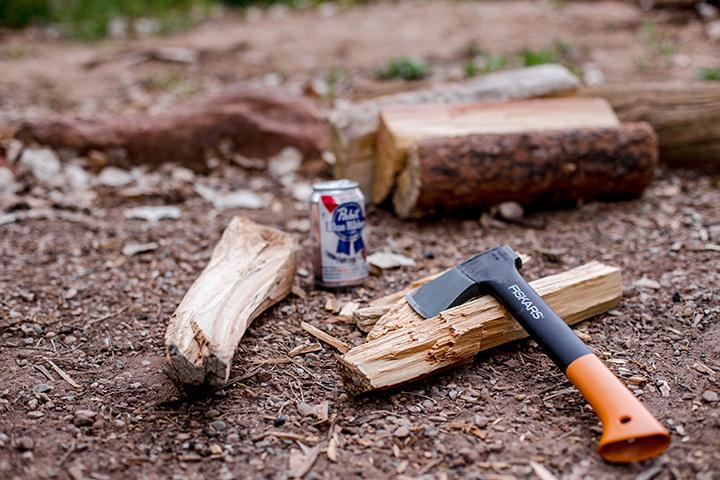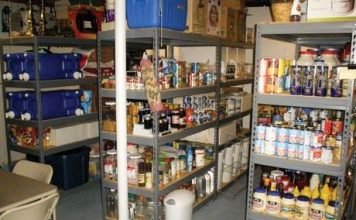| Issue #124 • July/August, 2010 |
For as long as I have been venturing into the backcountry, which is a pretty long time, I have been on a quest for the perfect backpacking stove. I have tried everything from the ultra-light micro stoves that run on butane to the cumbersome and messy white gas stoves, none of which I really liked. On a long hike I inevitably run out of fuel for my camp stove and have to hike off trail to restock or spend the rest of the trip eating granola bars and jerky.
The campfire is still best for cooking, but there are times when a campfire is not practical or legal, like during fire season in the national parks.
The wood burning stove
While surfing the internet, I finally hit upon a solution. Bushcraft Northwest had an article by Mike Lummio that shows how to convert a folding Sterno stove into a wood burning stove.
The advantage of the Sterno stove is that it’s light and folds as flat as road kill. When folded out it has a luxuriously large burner grate that will support an eight-inch frying pan. The conversion was simple too. Bend the prongs, which are designed to hold the can of sterno, out straight to hold dry kindling. Place a sheet of aluminum foil under the stove and load it with pine cones and dry twigs. Let it burn for a few minutes, adding to it, until you have a nice compact bed of coals, then flip up the lid and cook away.
Now, no matter how long my trek is, I have a ready source of fuel for the stove that I don’t have to lug on my back. It burns hotter than any butane or propane stove, and the wide cooking surface gives a broader heat distribution under the pan making it cook more evenly and faster.
|
The alcohol stove
But I decided I wanted a dual-fuel stove. Several websites I found showed how to make an alcohol stove out of pop cans. Apparently, a lot of through-hikers on the Appalachian Trail use these. I gave it a try, but was only marginally impressed. It barely put out enough heat to boil a cup of soup.
After some trial and error I was able to improve upon the idea and ended up with a great little stove for the price of a couple of beers, which of course I consumed while making the stove.
The best can I found for making an alcohol stove is a 25-ounce Foster’s beer can. This can has the largest circumference of any other can I have found, and it holds a significant amount of beer. You may want to invite someone over to help with consumption, since it does require two cans.
Another improvement is the type of fuel. Rubbing alcohol doesn’t burn as clean or as hot as I like, and can be difficult to find if you are popping into civilization only periodically to re-supply. Methyl alcohol burns clean and hot and is available whereever you find an auto parts store or gas station. Even most convenience stores carry it. It comes prepackaged in plastic bottles under the name “HEET,” and is used to de-ice fuel lines.
I also carry a 3-inch-long 2×4 block of kiln dried wood to set my alcohol stove on to get it closer to the pot. Kiln dried wood is light, and I shave it for some instant tinder when I burn wood in the stove.
This little stove combination is compact and only weighs about 15 ounces, including the 2×4 block. I carry about 1/3 less fuel, since I can usually burn wood instead of alcohol. It burns hotter and is more stable than the micro-stoves which are precarious when trying to balance a pot of boiling soup on their tiny little burners. And with this stove, there are no spent fuel cans to pack out and dispose of, just a little ash to scatter.
Now, when I wander off the trail back into civilization I often find I don’t even need to buy fuel since I haven’t had to use any alcohol. But there are times, after a long day of trudging through the rain, when I don’t feel like scouting around for dry tinder, so I just fill the alcohol stove and cook up a cup of soup while under my rain tarp.
The total cost is 12 to 15 bucks, plus the price of a couple of beers.
Make it
two 25-ounce Foster’s beer cans
drill and 5/64-inch drill bit
razor knife blade
a large heavy book
strip of fiberglass insulation
1. Drain one of the beer cans. Place the razor in the book as shown and hold the can against the razor as you turn the can. This will ensure an even cut all the way around. Don’t try to cut through the can on the first pass. Just keep light pressure and cut the can like a pipe cutter. This piece will be the bottom of your stove.
2. Take the cut piece and push onto the bottom of the unopened beer can. Work it around to expand the mouth of the bottom piece. This will make it easier to insert the top of the stove which is what you will make next.
3. Now you can go ahead and drink the other beer. When it’s drained, but before you cut the can, invert and drill holes around the perimeter of the can. Next, drill five fill holes in the center. No need to measure. Eyeballing it is close enough.
4. Cut the second can as before but make it about 1/8 inch taller since this piece will slide into the other and you want the lip of the bottom to be below the top of the burner.
5. Once cut, place a strip of fiberglass insulation around the bottom piece. You can now carefully slide the top inside the bottom. Once you get it started, rotate as you squeeze the halves together with your hands. It will snap each time you squeeze, which lets you know to rotate to the next position. When it stops snapping and it looks like it’s all the way on, it’s done. Some of the internet demos show sealing it with JB Weld, but it isn’t needed. You couldn’t get the halves apart if your life depended on it. You can now fill the stove with HEET and fire it up. Make a dish out of foil and dribble a little HEET around the burner. This will heat the burner and it will self-start. It doesn’t take much, so be frugal.




















Placing the upper half in the deep freeze for 15 minutes or so will shrink the aluminum enough that the two halves go together easier; however you do have to work fast before it heats back up.
I also sealed mine with aluminum tape.
It appears you are missing the key piece that makes alcohol stoves efficient: a ring of aluminum slightly smaller than the original can that fits snugly between the two halves of the stove to form a pressure chamber where the alcohol becomes vaporized. This is hard to picture, but go to https://zenstoves.net/Stoves.htm for everything there is to know about these stoves.